MiR-29c regulates the expression of miR-34c and miR-449a by targeting DNA methyltransferase 3a and 3b in nasopharyngeal carcinoma
- PMID: 26975503
- PMCID: PMC4791796
- DOI: 10.1186/s12885-016-2253-x
MiR-29c regulates the expression of miR-34c and miR-449a by targeting DNA methyltransferase 3a and 3b in nasopharyngeal carcinoma
Abstract
Background: Nasopharyngeal carcinoma (NPC) is prevalent in South East Asia and Southern China particularly, despite the reported 5-year survival ratio is relative higher than other deadly cancers such as liver, renal, pancreas cancer, the lethality is characterized by high metastatic potential in the early stage and high recurrence rate after radiation treatment. MicroRNA-29c was found to be down-regulated in the serum as well as in the tissue of nasopharyngeal carcinoma tissue.
Methods: In this study, we found accidentally that the transfection of pre-miR-29c or miR-29c mimics significantly increases the expression level of miR-34c and miR-449a but doesn't affect that of miR-222 using real-time quantitative PCR in nasopharyngeal carcinoma cell lines. To explore the molecular mechanism of the regulatory role, the cells are treated with 5-Aza-2-deoxycytidine (5-Aza-CdR) treatment and the level of miR-34c and miR-449a but not miR-222 accumulated by the treatment. DNA methyltransferase 3a, 3b were down-regulated by the 5-Aza-CdR treatment with western blot and real-time quantitative PCR.
Results: We found that pre-miR-29c or miR-29c mimics significantly increases the expression level of miR-34c and miR-449a. We further found DNA methyltransferase 3a and 3b are the target gene of miR-29c. Restoration of miR-29c in NPC cells down-regulated DNA methyltransferase 3a, 3b, but not DNA methyltransferase T1.
Conclusions: The regulation of miR-29c/DNMTs/miR-34c\449a is an important molecular axis of NPC development and targeting DNMTs or restoring of miR-29c might be a promising therapy strategy for the prevention of NPC.
Keywords: DNA methyltransferase; Nasopharyngeal carcinoma; miR-29c; miR-34c; miR-449a.
Figures
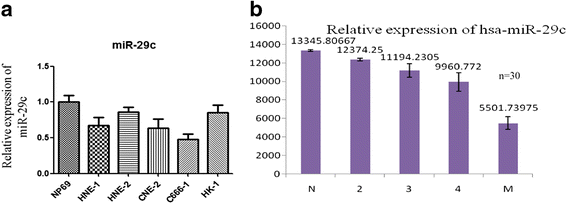
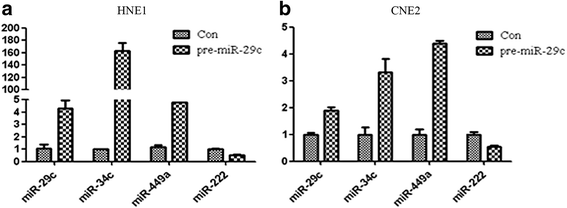
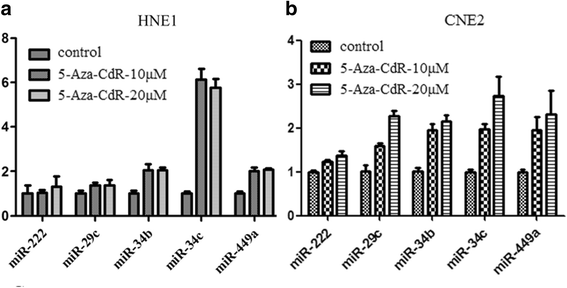

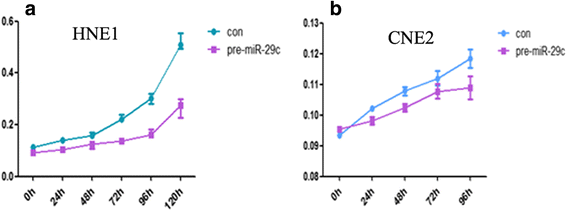

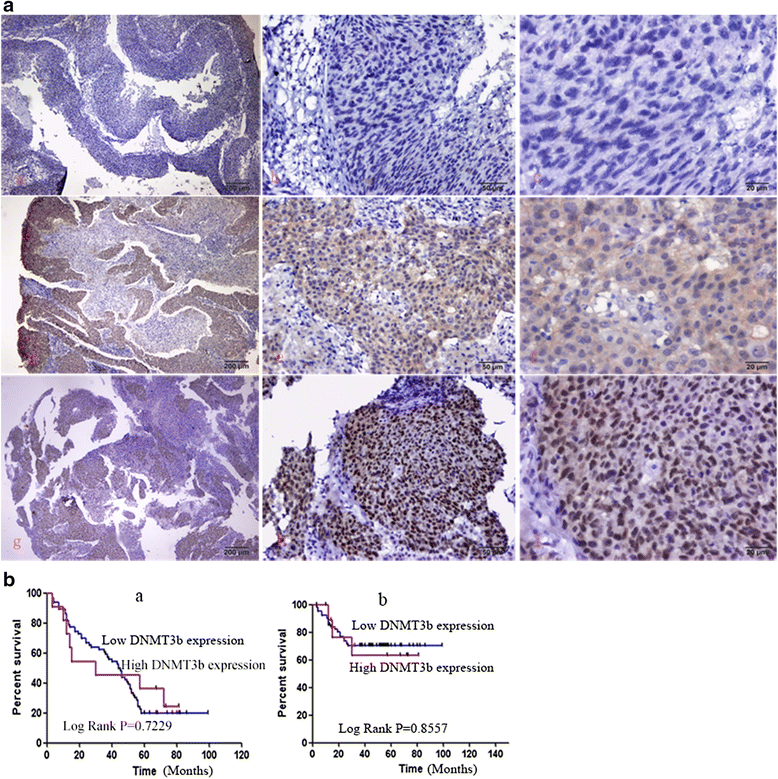
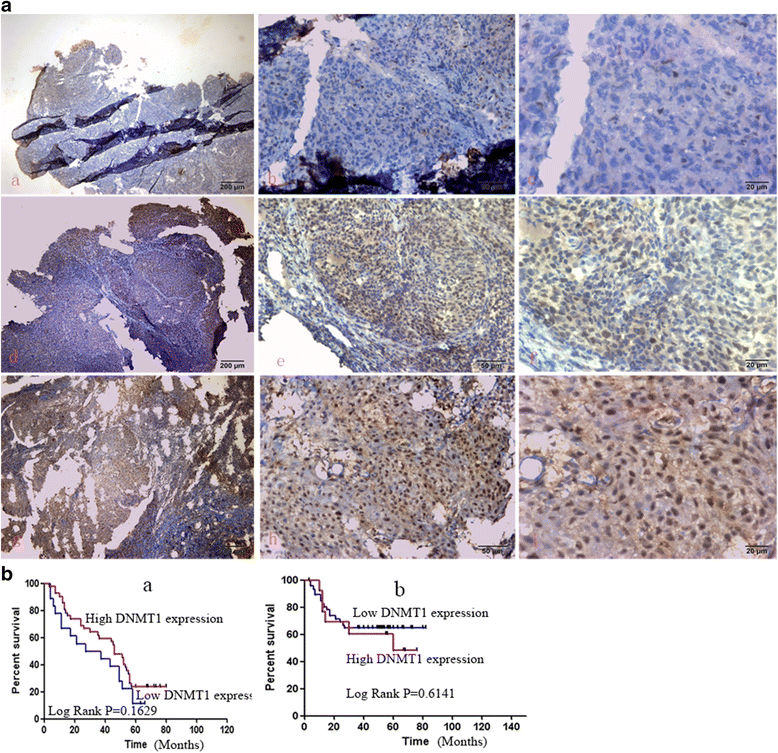
Similar articles
-
Downregulation of lncRNA X Inactive Specific Transcript (XIST) Suppresses Cell Proliferation and Enhances Radiosensitivity by Upregulating mir-29c in Nasopharyngeal Carcinoma Cells.Med Sci Monit. 2017 Oct 6;23:4798-4807. doi: 10.12659/msm.905370. Med Sci Monit. 2017. PMID: 28985197 Free PMC article.
-
MiR-34c suppresses tumor growth and metastasis in nasopharyngeal carcinoma by targeting MET.Cell Death Dis. 2015 Jan 22;6(1):e1618. doi: 10.1038/cddis.2014.582. Cell Death Dis. 2015. PMID: 25611392 Free PMC article.
-
MiR-34c downregulation leads to SOX4 overexpression and cisplatin resistance in nasopharyngeal carcinoma.BMC Cancer. 2020 Jun 26;20(1):597. doi: 10.1186/s12885-020-07081-z. BMC Cancer. 2020. PMID: 32586280 Free PMC article.
-
MiR-29c suppresses invasion and metastasis by targeting TIAM1 in nasopharyngeal carcinoma.Cancer Lett. 2013 Feb 28;329(2):181-8. doi: 10.1016/j.canlet.2012.10.032. Epub 2012 Nov 8. Cancer Lett. 2013. PMID: 23142282
-
MiR-34b-3 and miR-449a inhibit malignant progression of nasopharyngeal carcinoma by targeting lactate dehydrogenase A.Oncotarget. 2016 Aug 23;7(34):54838-54851. doi: 10.18632/oncotarget.10761. Oncotarget. 2016. PMID: 27458165 Free PMC article.
Cited by
-
Bovine milk consumption affects the transcriptome of porcine adipose stem cells: Do exosomes play any role?PLoS One. 2024 Dec 20;19(12):e0302702. doi: 10.1371/journal.pone.0302702. eCollection 2024. PLoS One. 2024. PMID: 39705291 Free PMC article.
-
Effects of alkaline water intake on gastritis and miRNA expression (miR-7, miR-155, miR-135b and miR-29c).Am J Transl Res. 2020 Jul 15;12(7):4043-4050. eCollection 2020. Am J Transl Res. 2020. PMID: 32774757 Free PMC article.
-
The essentiality of non-coding RNAs in cell reprogramming.Noncoding RNA Res. 2017 Apr 13;2(1):74-82. doi: 10.1016/j.ncrna.2017.04.002. eCollection 2017 Mar. Noncoding RNA Res. 2017. PMID: 30159423 Free PMC article. Review.
-
Small biomarkers with massive impacts: PI3K/AKT/mTOR signalling and microRNA crosstalk regulate nasopharyngeal carcinoma.Biomark Res. 2022 Jul 26;10(1):52. doi: 10.1186/s40364-022-00397-x. Biomark Res. 2022. PMID: 35883139 Free PMC article. Review.
-
Mir-29c Expression in Glioma and Its Effects on Tumor Cell Proliferation and Apoptosis.Iran J Public Health. 2020 Feb;49(2):304-311. Iran J Public Health. 2020. PMID: 32461938 Free PMC article.
References
-
- Liu WL, Lin YH, Xiao H, Xing S, Chen H, Chi PD, Zhang G. Epstein-Barr virus infection induces indoleamine 2,3-dioxygenase expression in human monocyte-derived macrophages through p38/mitogen-activated protein kinase and NF-κB pathways: impairment in T cell functions. J Virol. 2014;88(12):6660–71. - PMC - PubMed
-
- Yang X, Dai W, Kwong DL, Szeto CY, Wong EH, Ng WT, Lee AW, Ngan RK, Yau CC, Tung SY, Lung ML. Epigenetic markers for noninvasive early detection of nasopharyngeal carcinoma by methylation-sensitive high resolution melting. Int J Cancer. 2015;136(4):E127–35. - PubMed
Publication types
MeSH terms
Substances
LinkOut - more resources
Full Text Sources
Other Literature Sources

